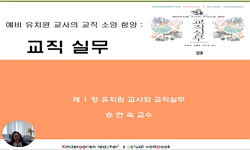Play enables preschoolers to build relationships with their peers, to represent their potentials, complaints, limits or needs and to satisfy the needs or release negative emotions in a positive way. Indeed, play exerts an influence on young children's...
http://chineseinput.net/에서 pinyin(병음)방식으로 중국어를 변환할 수 있습니다.
변환된 중국어를 복사하여 사용하시면 됩니다.
- 中文 을 입력하시려면 zhongwen을 입력하시고 space를누르시면됩니다.
- 北京 을 입력하시려면 beijing을 입력하시고 space를 누르시면 됩니다.
유치원에서의 자발적 놀이에 대한 현상학적 탐구 = Phenomenological Study of Spontaneous Play in Early Childhood Institution
한글로보기https://www.riss.kr/link?id=T14365074
- 저자
-
발행사항
부산 : 고신대학교 대학원, 2017
-
학위논문사항
학위논문(석사) -- 고신대학교 대학원 , 유아교육학과 유아교육 , 2017. 2
-
발행연도
2017
-
작성언어
한국어
- 주제어
-
발행국(도시)
부산
-
형태사항
121 ; 26 cm
-
일반주기명
지도교수: 권미량
- 소장기관
-
0
상세조회 -
0
다운로드
부가정보
다국어 초록 (Multilingual Abstract)
Play enables preschoolers to build relationships with their peers, to represent their potentials, complaints, limits or needs and to satisfy the needs or release negative emotions in a positive way. Indeed, play exerts an influence on young children's every part of life and overall development. But it should be noted here that play couldn't produce expected effects once the substance of play is removed, which is freedom and voluntary choice. In other words, it's quite important for preschoolers to play when they are motivated to do that. In early childhood education, educational institutions where young children spend a lot of time should assist them in playing voluntarily by being driven by their own inner motivations. In fact, however, they are sometimes forced to play with things designated by their teachers or according to specific plans in many educational institutions, though a variety of structural things to play with are provided. But they continue to attempt to satisfy their curiosity or interest through play while they spend time in educational institutions according to daily schedules, and curiosity and interest become motivations at that time. An effort to read their minds by making continuing observations of their play makes it possible to help them to play in a more extended and enriched manner, and gives a crucial clue on the right directions for early childhood education. However, it's not actually easy for researchers to keep observing young children while they play.
The purpose of this study was to examine play situations among the preschoolers in an educational institution where this researcher worked. It's basically meant to analyze the characteristics and significance of spontaneous early childhood play in the field of early childhood education.
A research question was posed:
1. What are the phenomenological characteristics of spontaneous early childhood play in the field of early childhood education?
The subjects in this study were the young children in a class of western age 3 in a kindergarten located in an urban community. Participant observations, videotaping and recording were all carried out to gather data. This researcher received guidance from an expert about how to make participant observations in advance, and then made participant observations of the play situations among the selected preschoolers during all the normal classroom hours to collect data on the types and meanings of spontaneous early childhood play. In the stage of observation, this researcher observed the young children while they play, and interacted with them only when they wanted to do that. The teacher who was in charge of the class was informed about what's observed without making it known to the preschoolers as much as possible. In this way, the observations were fulfilled according to the stages of sequential research that reduces time intervals between the stages of analysis, and what's observed was transcribed each day. In addition, all the preschoolers and their homeroom teacher were interviewed, and the interview data were analyzed to have a more perfect understanding of the significance of spontaneous early childhood play in the field of early childhood education. The collected data were analyzed to categorize the characteristics of spontaneous early childhood play according to Hatch(2008)'s inductive analysis theory that is to classify the characteristics of a phenomenon by grouping significant themes together.
As a result, verbal playfulness, projection of home and life, display of concerns, conflicts and reconciliation, and leading and extended learning.
Verbal playfulness appeared during their murmuring, imitating sounds, repeating words, combining words, exchanging lyrics, repeating lyrics, changing lyrics, picking at what one said, and word chain. That meant to take pleasure in speaking itself. As for projection of home and life, the young children's daily experiences at home, educational experience and other sorts of experience were unveiled through play. Concerning display of concerns, various things that they were interested in were represented. As to conflict and reconciliation, there were scenes of "conflict" when they failed to resolve their differences and when they denied each other's request, and there also appeared scenes of "reconciliation," which was done by soothing, suggesting, explaining or teacher intervention. Regarding leading and extended learning, the preschoolers led or followed each other while they played together, and then they played in applied or extended ways.
The findings of the study suggest that it's required to shed new light on the phenomena of play that take place in early childhood educational institutions where preschoolers spend many time in this era characterized by a crisis of play. Taking a phenomenological look at the actual cases of play among preschoolers makes it possible to categorize the characteristics of spontaneous early childhood play and to realize the importance of early childhood play once more.
But the findings of the study are not sufficient enough to find a solution for the crisis of play, because some extreme cases of spontaneous play were just mentioned without making any further efforts to categorize the characteristics of the cases or consider their meanings.
Finally, there are some suggestions on future research efforts:
First, observation data should be gathered both in and outside educational institutions to find out where and when spontaneous play frequently takes place in order to consider what limitations there are to spontaneous play in the educational institutions.
Second, it's necessary to suggest the right directions for spontaneous play in early childhood by squarely facing problems with spontaneous play among preschoolers in early childhood education institutions and by listening to the voices of early childhood educators. That will serve to determine the right direction for play in these educational institutions because that makes it possible to take a new phenomenological approach based on the perspectives or opinions of participants other than the researcher himself or herself.
If more extensive research is made to approach spontaneous early childhood play from a more critical perspective by making closer observations, by collecting more detailed data and by gathering opinions from various groups of people concerned, it will contribute to shedding new light on early childhood play and to leading educational institutions in the right direction.
국문 초록 (Abstract)
유아의 놀이는 또래와의 관계를 형성하기도 하고 잠재의식 속에 있는 가능성, 불만, 한계, 욕구 등을 표출해 냄으로써 긍정적인 방향으로 해소할 수 있도록 한다. 이처럼 놀이는 유아의 모든...
유아의 놀이는 또래와의 관계를 형성하기도 하고 잠재의식 속에 있는 가능성, 불만, 한계, 욕구 등을 표출해 냄으로써 긍정적인 방향으로 해소할 수 있도록 한다. 이처럼 놀이는 유아의 모든 생활과 전반적인 발달에 있어서 영향을 미친다. 그러나 놀이에서는 자유와 자발적인 선택이라는 본질이 사라지는 순간, 기대하는 효과를 얻을 수 없으므로 내면의 동기에 따르는 것이 중요하다. 유아들이 많은 시간을 보내는 유아교육기관을 비롯한 유아교육현장에서는 내적 동기에 따른 자발적 유아놀이가 이루어질 수 있도록 지원해주어야 한다. 그러나 실제로 많은 유아교육기관에서는 구조적 놀잇감을 다양하게 제공해주되, 교사가 놀잇감을 지정하거나 일정한 계획에 따라 이루어지는 경우가 있다. 그럼에도 유아들은 유아교육기관의 하루 일과를 보내는 중 내면의 호기심과 흥미를 동기화하여 놀이로 표출하고자 끊임없이 시도한다. 이렇게 시도되는 유아의 놀이를 지속적으로 관찰하여 유아의 생각과 행동 등을 읽어내는 행위는 나아가 유아의 놀이를 더욱 확장하고 심화시킬 수 있는 방법과 그것을 위한 유아교육현장의 방향에 대해 고민할 수 있는 밑거름이 된다. 그러나 연구자들이 실제 유아교육현장 속에 파고들어 유아의 일상적인 놀이를 지속적으로 관찰하기에는 여건상 어려움이 따른다.
따라서 본 연구는 연구자가 근무하고 있는 실제 유아교육기관에서 유아들을 대상으로 일과 중에 일어나는 놀이 상황을 관찰하고 분석하였다. 그리고 이것을 통해 유아교육현장에서 이루어지는 자발적인 유아놀이의 특성과 의미에 대해 살펴보고자 하였다.
본 연구는 이런 연구의 목적을 위해 다음과 같은 연구 내용을 설정하였다.
1. 유아교육현장에서 이루어지는 자발적 유아놀이의 현상학적 특성은 어떠한가?
본 연구는 U시에 위치한 H유치원의 만3세 한 반의 유아들을 대상으로 참여관찰 및 비디오 녹화, 녹음을 하였다. 참여관찰 전, 본 연구자는 전문가로부터 참여관찰에 관한 지도를 받았다. 연구자는 자발적 유아 놀이의 유형과 의미에 대한 자료를 수집하기 위하여 선정한 S반 유아들에게서 이루어지고 있는 놀이상황을 직접 참여관찰 하였다. 참여관찰은 S반의 정규반 일정에 따라 전반에 걸쳐 이루어졌다. 관찰의 단계에서 연구자는 유아들의 놀이를 지켜보고 유아 참여자가 원하는 경우에 한하여 상호작용을 하고, 관찰 사실은 함께 학급을 운영하는 교사 참여자에게만 알리고 관찰기간동안 되도록 유아 참여자에게는 노출되지 않게끔 계획하여 진행하였다. 이와 같이 참여관찰은 분석단계의 거리를 좁히는 순차적 연구 단계를 따랐으며, 매 회 일일관찰 한 것을 당일 전사 처리하여 자료화 하였다. 또한 유아교육현장에서의 자발적 유아놀이의 의미에 관해 조금 더 깊이 있게 이해하고 접근하기 위하여 S반 담임교사 및 S반 전체 유아들을 대상으로 면담을 실시하여 이를 분석하였다. 본 연구에서는 의미 있는 주제를 하나의 범주로 묶어 현상의 특성을 유목화 하는 귀납적 분석 과정을 제시한 Hatch(2008)의 이론에 기초하여 자발적 유아놀이 특성을 범주화하고 분석하였다.
이에 따른 연구 결과로 유아교육현장에서의 자발적 유아 놀이의 현상학적 특성에는 언어적 유희, 가정과 삶의 투사, 관심사의 표출, 갈등과 화해, 이끎과 배움의 확장의 형태로 나타났다.
언어적 유희는 중얼거리기, 소리흉내내기, 단어 반복하기, 단어 조합하기, 노랫말 주고받기, 노랫말 반복하기, 노랫말 바꾸기, 말꼬리물기, 말 잇기의 형태로 나타났으며, 말하는 그 자체에 대한 즐거움을 보이는 것이다. 가정과 삶의 투사는 가정에서의 일상적인 경험, 교육적인 경험, 그 외의 경험의 형태로 나타났다. 관심사의 표출은 유아들이 스스로 가지고 있는 다양한 관심 대상을 놀이 속에 등장시키는 형태로 나타났다. 갈등과 화해는 놀이를 함께 하는 유아들 간의 의견을 좁히지 못하거나 상대방의 요청을 거절함으로써 오는 ‘갈등’에서부터 달래기, 제안하기, 설명하기, 교사의 개입에 따른 중재를 통한 ‘화해’의 장면으로 나타났다. 이끎과 배움의 확장은 유아들의 놀이 속에서 또래를 이끄는 역할과 참여하고 따라가는 역할을 감당하며, 놀이를 응용하고 확장시키는 형태로 나타났다.
본 연구를 통하여 놀이의 위기를 맞이한 현 시대의 유아들이 하루 중 많은 시간을 보내는 유아교육기관에서 보이는 놀이의 현상에 대해 새롭게 재조명 할 필요가 있음을 시사하였다. 유아들의 실제 놀이 장면 사례를 통해 유아교육현장을 현상학적으로 들여다봄으로써 자발적 유아놀이의 특성을 범주화 하고 이에 따라 유아놀이의 중요성을 다시금 인식할 수 있었다.
그러나 자발적 놀이 형태가 극대화되는 상황을 놀이 사례에서 언급은 하였으나 이러한 측면에서 범주화 하는 작업이나 의미를 도출해내는 작업이 이루어지지 않아 놀이 위기에 맞서는 현실적 대안을 모색하기 위한 기초자료로 쓰이기에는 부족하다.
따라서 본 연구에 대한 제언을 하자면,
첫째, 유아교육기관에의 실내뿐만 아니라 실외까지 모두 통틀어 관찰 조사하여 얻어진 자료를 바탕으로 유아교육기관 내에서 자발적 유아놀이가 빈번하게 발생하는 장소나 특정 시간대에 따라 범주화 하여 유아교육현장에서의 자발적 유아놀이의 한계점에 대해 고민하는 연구가 이루어져야 할 것이다.
둘째, 현재 유아교육기관에서 이루어지고 있는 유아의 자발적 놀이에 대한 비판적인 자세로 문제를 직시하는 노력과 동시에 유아교육현장에서 함께 하는 이들의 이야기에서 새로이 의미를 도출하여 유아의 자발적 놀이를 위한 유아교육현장의 방향을 제시하는 연구가 이루어져야 할 것이다. 연구자 이외의 다른 연구 참여자의 관점이나 의견으로부터 새로운 현상학적 관점으로의 접근이 가능하기 때문에 유아의 놀이를 위한 유아교육기관의 바람직한 방향과 방안을 제시할 수 있을 것이다.
본 연구를 바탕으로 조금 더 관찰 내용과 자료들을 세분화하고, 유아교육현장과 관련된 참여자들의 의견을 분석하여 비판적인 관점으로 접근하는 등 포괄적이고 종합적인 연구가 이루어진다면, 현장에서의 유아놀이에 대한 재검토뿐만 아니라 유아의 자발적인 놀이를 위한 유아교육기관의 방향과 방안을 구체적으로 제시할 것으로 기대해 본다.
목차 (Table of Contents)
- Ⅰ. 서론 1
- 1. 연구의 필요성 및 목적 1
- 2. 연구내용 5
- 3. 용어의 정의 5
- Ⅰ. 서론 1
- 1. 연구의 필요성 및 목적 1
- 2. 연구내용 5
- 3. 용어의 정의 5
- Ⅱ. 이론적 배경 7
- 1. 놀이의 개념과 속성 7
- 2. 자발적 놀이 14
- 3. 유아놀이에 대한 현상학적 접근 20
- Ⅲ. 연구절차 및 방법 23
- 1. 연구대상 23
- 2. 연구방법 24
- 3. 자료분석 35
- Ⅳ. 자발적 유아놀이에 대한 현상학적 탐구 36
- 1. 언어적 유희 36
- 2. 가정과 삶의 투사 48
- 3. 관심사의 표출 64
- 4. 갈등과 화해 77
- 5. 이끎과 배움의 확장 89
- Ⅴ. 논의 및 제언 102
- 1. 요약 및 논의 102
- 2. 제언 107
- 참고문헌 109
- Abstract 118












